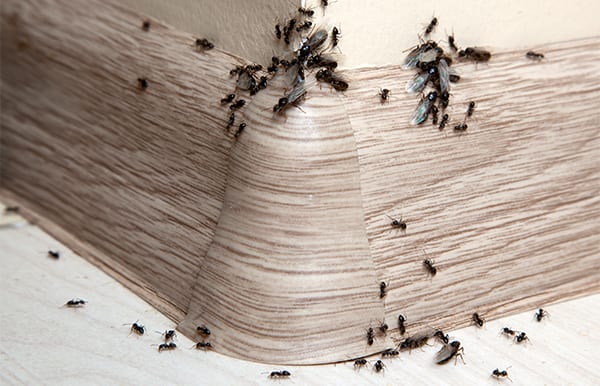
Pest
Nuisance Ants
Pest Category
Nuisance Ants
Do They Carry Disease?
No
Do They Cause Structural Damage?
Yes
Cost of Damage

Other Damage?
Psychological. These ants can infest and cause to be wasted large stores of food products.
Signs to Look For
Ants foraging in and around structures; piles of sand/dirt at cracks and crevices in sidewalks and concrete/asphalt slabs. These ants are typically first noticed in and around kitchens and bathrooms…on the counters and around sinks, cupboards, cabinets and plumbing fixtures where they are foraging for food and moisture. They get worse as the season goes on and the colonies continue to grow. They do not go away on their own, they have to be forced to leave.
Where are they noticed?
Can be seen anywhere in a structure. Noticed normally in kitchens and bathrooms, around concrete slabs, garden beds etc…
If Untreated…
The infestation will continue to grow until a point where no part of the structure will be free from ant activity.
Habits
Prefer nesting in warm, moist areas. Often found inside homes in attics, crawlspaces and wall voids. Can also be found nesting under concrete slabs, driveways and in flower beds. Prolific foragers, traveling large distances in search of food. Noticed primarily in warmer months. Colonies can have more than one queen and any structure can be home to multiple colonies. Treatments usually require visits over a longer period of time.
Tips
Over the counter products offer a temporary fix, but this species of ant will be back. The right products applied in the correct manner make all the difference in being rid of this pest. Non-residual products, as well as ant baits, reach the queen at the heart of the colony. Over the counter products, while they can kill worker ants, will alert the rest of the colony to danger. This, often times, forces the colonies to move to different parts of the structure and can also cause the colonies to split and create what are known as “satellite colonies”. When this happens the infestation worsens. Do it yourself methods are especially discouraged with this species of ant.
You want a company to show up quickly, on time, and get rid of the pests that are bothering you. That is exactly what we specialize in. We are a family owned company with over 22 years experience that relies on service, not sales gimmicks.
Our philosophy is simple: We strive for excellence. Every employee in our company has this memorized, How we define excellence: “Giving the customer what they’re paying for, NO short cuts.” It is that simple. Our mission is to show up on time and get rid of the problem. No hassles. You can ask anyone in our company what our motto is and the answer will be the same.
No sales gimmicks or tricks. We’re consumers like everyone else, and don’t like someone trying to sell us something we don’t need, so we don’t do it here. We will tell you what you need, not what we want you to buy. That’s why we don’t make our customers sign contracts or remain obligated. You can use us for one service or many. We leave the decision up to you.
We are a service based business not a sales based business. Show up on time and do what you’re supposed to do. I am amazed at how many customers don’t expect this anymore from the companies they hire. When a company is providing an excellent service then referrals and increased sales are a natural result.
We've been the recipient of the Angi Super Service Award for 11 consecutive years






We Proudly Service these Cities and Surrounding Areas:
Get a Free Estimate
Or Schedule Service
(877) 844-2847
Sign up to receive our latest offers
Give us your name and email and we’ll send you the latest news and offers from Classic Pest Control and Insulation.
